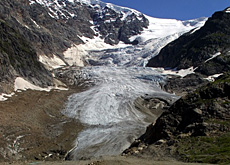
Glaciers set to disappear from the Alps

Scientists have warned that the Swiss Alps will no longer be covered by ice at the end of the century if glaciers continue to melt at the current rate.
Glaciers this year lost up to four per cent of their mass, according to experts from the Federal Institute of Technology in Zurich.
“Ten years from now about 20 per cent of the ice will have melted away,” says glaciologist Martin Funk.
He says the glaciers under observation have all lost up to 2,5 metres in thickness and they continued to shrink, according to measurements made between August and October this year.
The Aletsch glacier for instance receded by 50 metres, while the Trift glacier also melted but less dramatically than in previous years.
Latest preliminary results by scientists show the past summer was almost as damaging for the glaciers as the exceptionally warm summer in 2003.
The scientist points out more large pools have formed where the ice is melting at the mouth of the glaciers.
Huge ice blocks falling into the lakes, which could be as long as 1.6 kilometres and 125 metres deep, can cause flooding in valley floors, Funk says.
Dry valleys
The shrinking glaciers have not yet had a major impact on the flora and fauna of the Swiss Alps. But changes to the natural alpine environment are expected in the long run and scientists have expressed concern that some mountain valleys could lose their water resources.
The trend is irreversible and could lead to all but a few mountain regions about 4,000 metres altitude to be bare. Covering a glacier with sheets, as has been done in the past few years, can be effective, says Funk.
But he adds the measure can’t be applied on a big surface. Funk says the only realistic way of halting the melting is a reduction in green house emissions.
“But we won’t see any improvement right away even if we begin [to cut CO2 emissions] today,” he says.
Funk adds that it is very difficult to make accurate long-term forecasts, because of unforeseen events in nature such as a major volcano eruption. This could lead to a drop in temperatures as fine particles reduce the intensity of the sun’s rays.
swissinfo with agencies
There are about 1,800 glaciers in the Swiss Alps.
Last year 84 of the 91 glaciers under observation receded.
During the hot summer of 2003 between 5-10% of the glacier surface melted.
Between 1850 and 1975 the major glaciers lost half their mass.
It’s believed temperatures in Switzerland will rise by 2 degrees Celsius in winter and 3°C in summer within the next 50 years.
Switzerland has pledged a 10% reduction in CO2 levels by 2010.
The Swiss CO2 law formally took effect in 2000 and foresees additional measures if targets cannot be met by voluntary means.
Last October the authorities agreed to introduce a levy on petrol and diesel on a trial basis, following opposition against a mandatory CO2 emission tax.

In compliance with the JTI standards
More: SWI swissinfo.ch certified by the Journalism Trust Initiative



























You can find an overview of ongoing debates with our journalists here . Please join us!
If you want to start a conversation about a topic raised in this article or want to report factual errors, email us at english@swissinfo.ch.